#Medeia Helio
Explore tagged Tumblr posts
Text
Wind/Storm/Rain Gods
Zeus Hera Aiolos the Anemoi Poseidon Athene Hermes the Pleiades the Hyades the Nephelai/Okeanids Eos Aura the Aurai Oreithyia Khione Artemis (frost goddess) Iris Kymopoleia the Harpyiai the Hekatonkheires the (elder/immortal) Kyklôpes the Gorgones *Dionysos Hyes (Huês)
Flower Gods
the Anthousai/Leimenides Demeter Persephone Hera Aphrodite the Kharites the Horai (3 Seasons) Khloris Dionysos
Magic/Spells/Curses
Hekate Hermes Enodia Selene Helios Demeter Persephone the Erinyes Kirke Nyx Melinoe Medeia Artemis Persêis Pasiphaê Haides the Arai
#hellenic polytheism#hellenic paganism#hellenic gods#hellenic deities#helpol#hermes deity#zeus deity#hera deity#artemis deity#demeter deity#persephone deity#hekate deity#aphrodite deity#dionysos#dionysus deity#athene#athena deity#poseidon deity#the nymphai#helios deity#selene deity#the kharites#the horai
33 notes
·
View notes
Text


8 notes
·
View notes
Text
Medea: I'm gonna need a human skull and I can't have you ask any questions why.
Helio: Only if you also don't ask why
Helio: *Pulls out 7 pristine human skulls* Take your pick.
Medea:
Helio:
Medea: This one is fine
#incorrect your throne quotes#your throne incorrect quotes#your throne#i want to be you just for a day#i want to be you just for one day#i wanna be u#la duchesse déchue#medea solon#medeia belliard#medea belial#helio trophium#helio niccolo
121 notes
·
View notes
Text
An Introduction to Worshipping Medeia
As a Hellenic witch, the worship of Medeia is an important part of my practice. She was a witch and priestess of Hekate, possessing nearly unparalleled knowledge of magic and poisons. I wanted to write this post to give some background on who Medeia is, her role as a witch and a priestess, and how I have come to honor her in my practice.
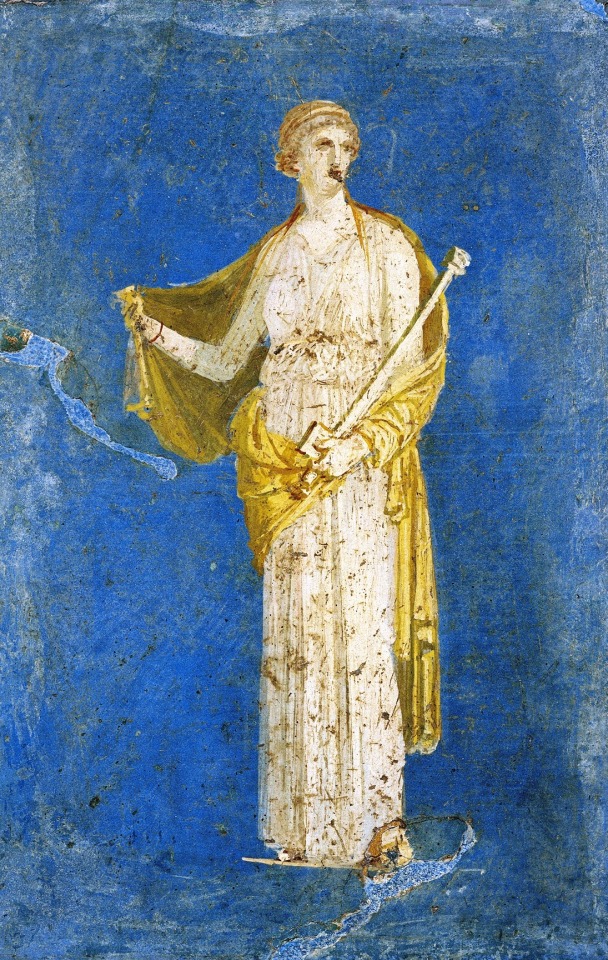
Who is Medeia?
Parentage
Medeia (Μήδεια) is given mainly two parentages, either Aeetes, son of Helios, and Eidyia, daughter of Oceanus, or Hekate and Aeetes. Hesiod offers us a description of the first, writing:
“To the tireless Sun the renowned Oceanid Perseïs bore Circe and King Aeetes. Aeetes, son of the Sun who makes light for mortals, married by the gods’ design another daughter of Oceanus the unending river, fair-cheeked Idyia; and she bore him the trim-ankled Medea, surrendering in intimacy through golden Aphrodite” (Hesiod 31)
Alternatively, Diodorus names Hekate and Aeetes as her parents, explaining:
“Perses had a daughter, Hecate, and she excelled her father in her brazen lawlessness...She was a keen contriver of mixtures of deadly drugs [pharmaka], and she discovered the so-called aconite. She tested the powers of each drug by mixing it into the food given to strangers...After this she married Aeetes and gave birth to two daughters, Circe and Medea, and also a son Aigialeus” (qtd. in Ogden 78)
Either of these parentages could make sense, but I personally observe the first.
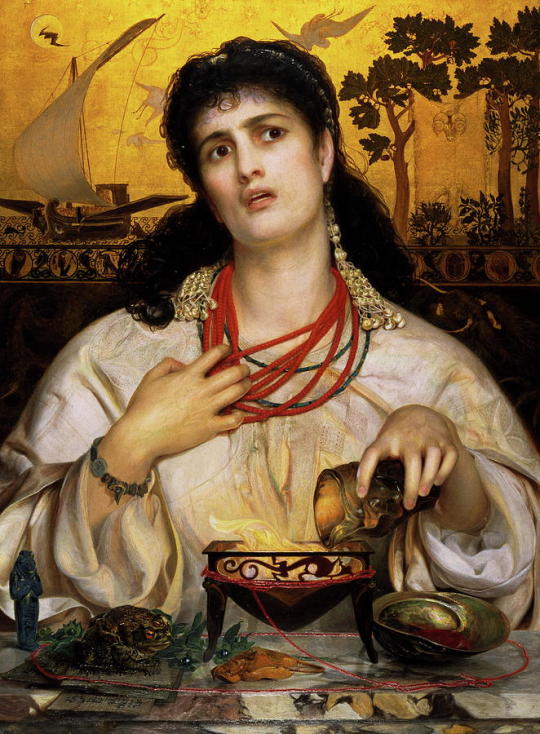
(Art: Medea by Frederick Sandys)
Medeia as the Witch Priestess of Hekate
One of Medeia’s most important roles in literature and myth is that she is a priestess of Hekate and a witch, being called “Medea of the many spells” (Apollonius of Rhodes 109). In most literature there is no way to separate these roles.
She was extremely devoted to Hekate, Apollonius of Rhodes stating that “as a rule she did not spend her time at home, but was busy all day in the temple of Hecate, of whom she was priestess” (116). Euripides also writes that Medea says “I swear it by her, my mistress, whom most I honor and have chosen as partner, Hecate, who dwells in the recesses of my hearth” (Euripides 13). Clearly, the relationship between her and Hekate was very close, and it was said on occasion that she even learned magic from Hekate, Herself. Apollonius of Rhodes writes that “[t]here is a girl living in Aeetes’ palace whom the goddess Hecate has taught to handle with extraordinary skill all the magic herbs that grow on dry land or in running water” (123). Diodorus also claims this, but adds an interesting addendum that attributes to the character of Medeia:
“They report that Medea learned all the powers of drugs from her mother [Hekate] and her sister [Kirke], but her own inclination was the opposite. For she continually saved the strangers that put in from dangers” (qtd. in Ogden 79)
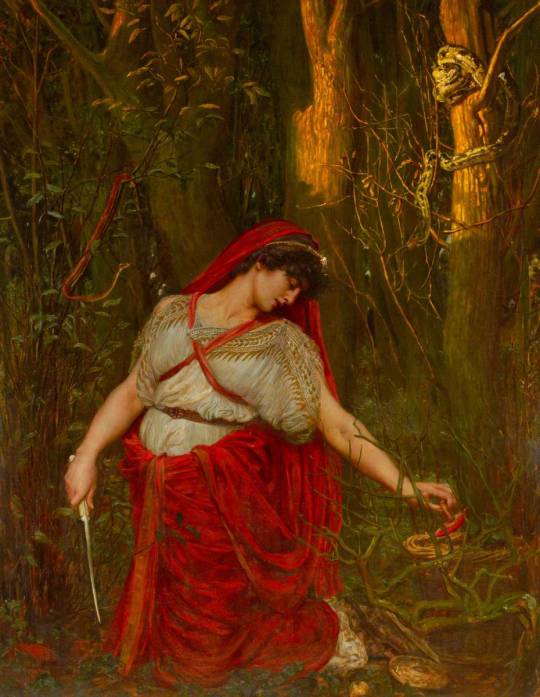
(Art: Medea the Sorceress by Valentine Cameron Prinsep)
Regardless of the origins of her powers, they were no doubt incredible. Apollonius of Rhodes explains that “she can put out a raging fire, she can stop rivers as they roar in spate, arrest a star, and check the movement of the sacred moon” (123). In one instance Apollonius states that “the beautiful Medea spell through the palace, and for her the very doors responding to her hasty incantations swung open of their own accord...From there she meant to reach the temple. She knew the road well enough, having often roamed in that direction searching for corpses and noxious roots, as witches do” (148). This is clearly an indicator that her powers are incredible, but what is even more awe-inspiring is what Apollonius says happens next:
“Rising from the distant east, the Lady Moon [Selene], Titanian goddess, saw the girl wandering distraught, and in wicked glee said to herself: ’So I am not the only one to go astray for love, I that burn for beautiful Endymion and seek him in the Latmian cave. How many times, when I was bent on love, have you disorbed me with your incantations, making the night moonless so that you may practice your beloved witchcraft undisturbed!” (148).
Medeia is said to be able to actually banish the moon Herself from the sky, an unimaginable feat. This is indicative of the degree of power she possesses, having sway over nature itself.
She is most known to have used her knowledge and powers repeatedly to help Jason, her husband, on his quest for the Golden Fleece. The first instance of this was that she made Jason an ointment which would make him invincible. Apollonius describes this in length, writing that:
“She had twelve maids, young as herself and all unmarried...She called them now and told them to yoke the mules to her carriage at once, as she wished them to drive to the spending Temple of Hecate; and while they were getting the carriage ready she took a magic ointment form her box. This salve was named after Prometheus. A man had only to smear it on his body, after procreating the only-begotten Maiden [Hekate] with a midnight offering, to become invulnerable by sword or fire” (131-2)
He continues, detailing the ritual of how she obtained the plant she used to make this ointment:
“Medea, clothed in black, in the gloom of night, had drawn off this juice in a Caspian shell after bathing in seven perennial streams and calling seven times on Brimo, nurse of youth, Brimo, night-wanderer of the underworld, Queen of the dead. The dark earth shook and rumbled underneath the Titan root when it was cute, and Prometheus himself groaned in the anguish of his soul” (132).
Here we see a process that is depicted often, the bathing of Medeia and her ritualistic harvesting of herbs. We also see her here call on Brimo (Βριμω), an epithet of Hekate, in Her role as nurse of the young (Kourotrophos/Κουροτρόφος), night-wanderer (Νυκτιπολος/Nyktipolos), of the Underworld (Χθονιη/Kthonia), and Queen of the Dead (Ανασσα ενεροι/Anassa Eneroi), indicating the importance of Hekate to her witchcraft.
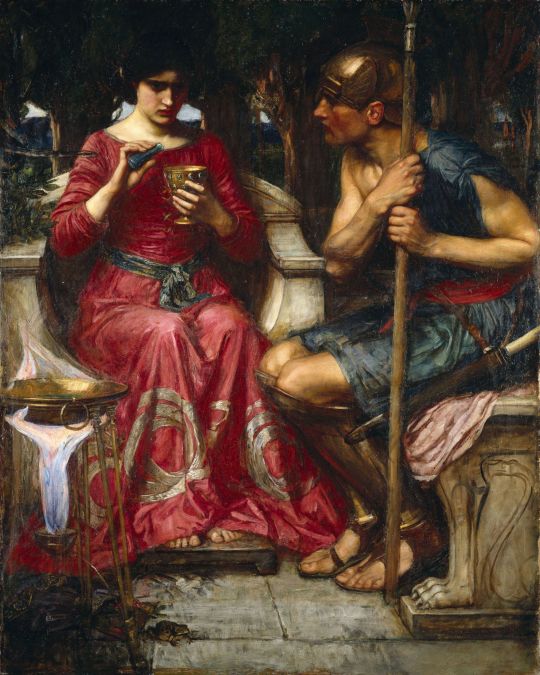
(Art: Jason and Medea by John William Waterhouse)
A similar harvesting of herbs and roots is seen in fragments of Sophocles’ play The Root-Cutters. What we have of the play states that “She [Medea] covers her eyes with her hand and collects up the white-clouded juice that drips from the cut in bronze jars...the covered chests conceal the roots, which this woman reaped, naked, with bronze sickles, while crying out and howling” (qtd. in Ogden 83). Hekate is then said to be “crowned with oak branches and snakes” (qtd. in Ogden 83). Then the women chant “Lord of the sun and holy fire [Helios], sword of Hecate of the roads, which she carries over Olympus as she attends and as she traverses the sacred crossroads of the land, crowned with oak and the woven coils of snakes, falling on her shoulders” (qtd. in Ogden 83). In this short but incredible fragment we see that Medeia calls on both Hekate and Helios, her grandfather, to bless their ritual. We also see a repeat of incantations to harvest magical herbs, and an introduction of her association with bronze.
Another one of Medea’s feats was charming the snake that guarded the Golden Fleece into a slumber. In the Argonautica, Apollonius of Rhodes writes:
“The monster in his sheath of horny scares rolled forward his interminable coils, like the eddies of black smoke that spring from smoldering logs...But as he writhed he saw the maiden take her stand, and heard her in sweet voices invoking Sleep [Hypnos], the conqueror of the gods, to charm him. She also called on the night-wandering queen of the world below [Hekate] to countenance her efforts...the giant snake, enchanted by her song, was soon relaxing the whole length of his serrated spine and smoothing out his multitudinous undulations...Yet his grim head still hovered over them and the cruel jaws threatened to snap them up. But Medea, chanting a spell, dipped a fresh sprig of juniper in her brew and sprinkled his eyes with her most potent drugs and as the all-pervading magic scent spread around his head, sleep fell on him.” (150-1).
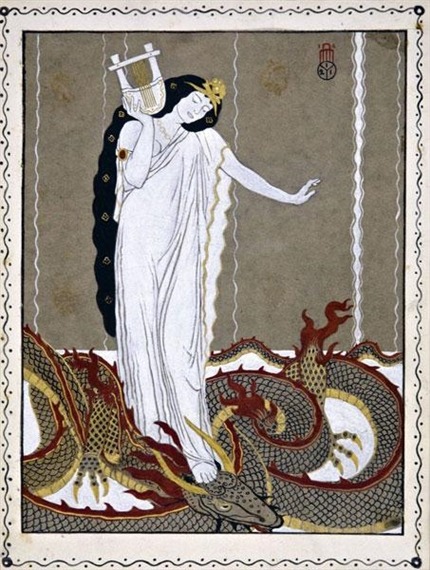
(Medea and the Dragon by Maxwell Ashby Armfield)
She was also said to have killed the giant Talos, a gift given to Zeus from Hephaistos, with her witchcraft, specifically the Evil Eye. In this more horrifying passage, it is said that:
“[W]ith incantations, she invoked the Sprits of Death [Keres], the swift hounds of Hades who feed on souls and haunt the lower air to pounce on living men. She sank to her knees and called upon them three times in song, three times with spoken prayers. She steeled herself with their malignity and bewitched the eyes of Talos with the evil in her own. She flung at him the full force of her malevolence, and in an ecstasy of rage she plied him with images of death” (Apollonius of Rhodes 192).
In this passage, she calls on the Keres, and with them is able to use the evil eye to bring immediate death to a direct creation of the gods. This is a horrifying feat, not only for the power it must require, but for her ability to kill in an instant.
Finally, she also is said to have rejuvenated Jason’s father Aeson. In Ovid’s Metamorphoses, Jason pleads with Medea to take years of his own life to give more to his father, but she rejects him saying that Hekate will not allow such a thing to take place. Instead, she offers that through her witchcraft, instead, if Hekate is willing to help her, she may rejuvenate him. Under the full moon, Medeia performs the ritual. She calls on Hekate, Night, the Moon, and Helios to aid her in her task (126-7). A chariot drawn by dragons appears to her and she takes it to gather herbs harvested with her bronze scythe. After nine days and nights, she returns to Jason to perform the ritual. The ritual is extensive and is essentially repeated in full. She builds two altars, one to Hecate and one to Hebe. She also digs two ditches on sacrifices a black sheep into the ditches, also pouring wine and milk into them. She also calls on the “deities of the earth” which may mean deities of the land or chthonic deities, and Hades. Once she appeases these gods and goddesses, she spells Aeson to sleep on a bed of herbs and tells Jason to leave her to perform her magic. She then dips sticks into pools of blood and lights them with the flames on the altars, then purifying the man once with fire, three times with water, and three times with sulfur.
She then adds many herbs, roots, and flowers to her bronze cauldron as well as “hoar frost gathered under the full moon, the wings of the uncanny screech owl with the flesh as well, and the entrails of a werewolf which has the power of changing its wild-beast features into a man’s. There also in the pot is the scaly skin of a slender Cinyphian water-snake, the liver of a long-lived stag, to which she also adds eggs and the head of a crow nine generations old” (Ovid 129). Then, she slits the throat of Aeson and replaced his blood with her potion, finally rejuvenating him.
There is more descriptions of Medeia’s magical feats throughout literature, but these are simply some of the most detailed and famous. She is clearly a very powerful witch and a significant figure within the history of Hekate worship. With her bronze cauldron and chariot of dragons, she is quite awe-inspiring.

(Art: The Sorceress by R. Willis Maddox)
Medeia’s Character
One of the issues we run into with Medeia’s mythos is her defamation and portrayal as a child-murdering and vengeful woman. She is indeed vengeful against Jason, and rightfully so, for he bade her to leave her homeland, murder her brother, and constantly had her aid him with her witchcraft, only to abandon her for another. However, Euripides’ tale of her brutally murdering her children has some criticisms from scholars who note that there are other versions of the tale.
One such tale is that from Apollodorus who writes that “Another tradition is that on her flight she left behind her children, who were still infants, setting them as suppliants on the altar of Hera of the Height; but the Corinthians removed them and wounded them to death” (1.9.28). In the modern era, a scholar named Sarah Illes Johnston, author of Restless Dead and Hekate Soteira, also writes that Medea prays to Hera Akraia to make her children immortal, and Hera either declines or breaks her promise to fulfill this task, leaving the children to die (62-3). Johnston denies the implication of Medea in her children’s death, instead attributing it to circumstances outside her control or by the hand of another.
These different tellings of Medeia’s story fits with the Colchian princess who aids Jason in a much more believable way than the suddenly spiteful women who murders her children. This variation is less popular, the other being popularized perhaps to demonize magic and women of power.
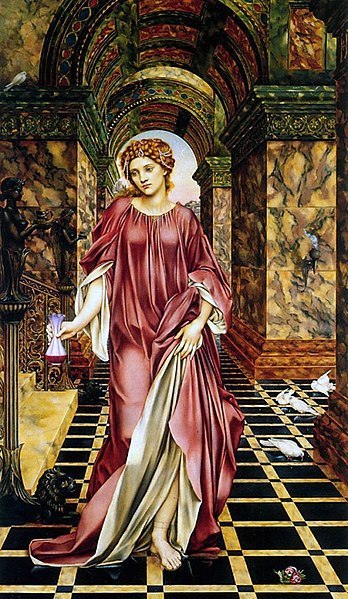
(Art: Medea by Eve De Morgan)
Worshipping Medeia
Now that Medeia’s character and mythological status has been discussed, I think it’s important to talk about how I actually go about worshipping Medeia. I worship Medeia in both divine and ancestral ways, which I suppose could be attributed to methods of hero worship in Ancient Greece. Worshipping Medeia can be done alongside Hekate and/or Helios, as well as alongside Kirke. If you observe the Mighty Dead or Witch Ancestors, she could also be worshipped alongside them.
Offerings
Offerings for Medeia can include wine, frankincense, milk, honey, food, poisons, sacred plants, bronze artifacts, candles, snake parts or figurines and dragon figurines, artifacts of witchcraft, and even Hekate iconography. One could also offer her blood, but that is up to your personal discretion.
Names and Epithets
Names/epithets I call Medeia include ‘Of the Many Spells,’ ‘Vengeful Maiden,’ ‘Witch Priestess of Hekate,’ ‘Medea of Poisons,’ ’She Who Knows All Herbs,’ ‘Giant-Slayer,’ one that could also be said of Hekate, ‘Princess of Colchis,’ ‘Granddaughter of Helios,’ ’Daughter of Sun and Moon,’ one I use to indicate her relationship to Helios and her devotion to Hekate, and Medea Pharmakeia, or Medeia of Witchcraft/Magic.
Sacred Objects
Sacred plants of Medeia could include any poisons, juniper, olive, and aconite specifically. Sacred animals include dragons and snakes. Bronze is also sacred to Medea, as are cauldrons of any kind.
Specializations
Medeia can be called upon for justice and vengeance, especially for spells of justice and vengeance, witchcraft of any kind, to bless herbs, for gardening, for aid in Hekate worship, for the downfall of your enemies, for protection from harm, for protection from snakes, and for guidance in magic.
Prayers to Medeia
Prayer for Medea’s Aid in Witchcraft
Prayer to Medea for Vengeance
Conclusion
In conclusion, while Medeia may not be a part of the usual canon of hero worship, or worship in general, if you are a devotee of Hekate or Helios, worshipping Medeia might be right for you. Likewise, any witch who observes the Hellenic pantheon should give serious thought to venerating Medeia in their practice.
Works Cited:
Medea by Euripides
Magic, Witchcraft, and Ghosts in the Ancient Greek and Roman Worlds by Daniel Ogden
The Voyage of Argo by Apollonius of Rhodes
Theogony by Hesiod
The Library by Apollodorus
The Metamorphoses by Ovid
“Corinthian Medea and the Cult of Hera Akraia” by Sarah Illes Johnston
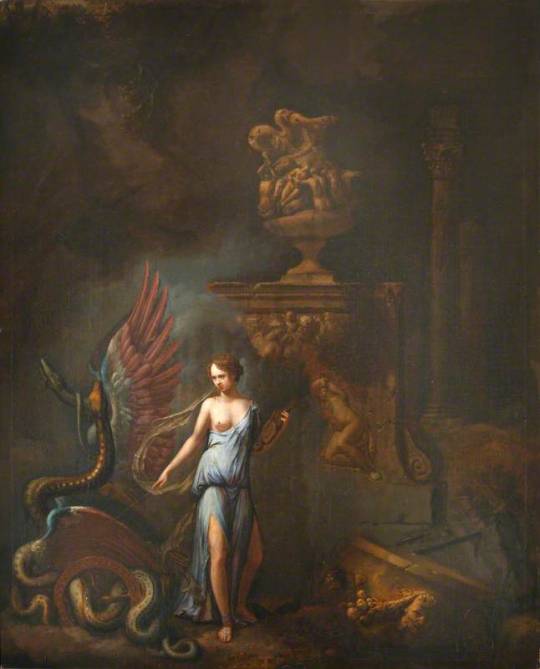
(Art: Medea Casting Spells by Henry Ferguson)
#Medea#Medea worship#hellenic polytheism#hero worship#witchcraft#witch#paganism#Hekate#hecate#hellenic witchcraft#hellenic heroes
2K notes
·
View notes
Note
hi, i was the anon who asked about the body-switch manhwa, takes a while to remember the title in english because in my webtoon's language it's called "i wanna be u" ;;;;;
i'm happy to hear you'd write manhwa thirsts! because... medeia... hey get in line helio-
hi hi anon!

ooh, that's actually pretty cool because that's how the manhwa originally starts off, but then the plot thickens and it gets hella good and aksjnxakbc,,
seriously, medea has to be my favorite bc while she is cunning and always scheming, she has her more tender moments to show that she's still human and still has a heart. i do appreciate that she and her brother have a, y'know, actually normal sibling relationship. i cannot tell you how many times i've seen stories where either sibling get their freak on with the other and i'm left to question why humanity was made.
but yes, i do accept manhwa thirsts! i'm actually surprised not a lot of people write for manhwa's considering that there are some interesting characters in them,,
2 notes
·
View notes
Photo


Medeia of Colchis, Granddaughter of Helios by gravelgirty
#Medeia#Medeia of Colchis#Helios#Helios' granddaughter#Jason and the Argonauts#Georgia#Black Sea#Ram sacrifice#bay laurel#divination#Ancestor Cult
1 note
·
View note
Text
Tôi Muốn Trở Thành Cô Ấy Chỉ Một Ngày: Ai Sẽ Giúp Chúng Ta Gánh Lấy Bất Hạnh?
Bộ truyện Tôi Muốn Trở Thành Cô Ấy Chỉ Một Ngày mở đầu với những tình tiết đầy thù hận: một người hạnh phúc, một kẻ đớn đau. Một người bị tước mất tất cả, rơi vào nỗi căm phẫn đen tối, một người tươi cười rạng rỡ dưới ánh bình minh, sung sướng đón nhận tất cả điều tốt đẹp nhất…
Thế nhưng, sự thật có phải như những gì mà mọi người nhìn thấy? Phải chăng nhìn thấy được đều là những điều đáng tin, đều là sự thật?
Thông tin chung về truyện Tôi Muốn Trở Thành Cô Ấy Chỉ Một Ngày
Bộ truyện Tôi Muốn Trở Thành Cô Ấy Chỉ Một Ngày là một truyện manhwa với đầy đủ màu sắc ở các trang truyện, được sáng tác và minh họa bởi tác giả Sam (삼). Truyện thuộc thể loại bạo lực, bí ẩn, tâm lý, huyền huyễn và có nhiều tình tiết lãng mạn.
Truyện ra mắt độc giả lần đầu vào năm 2019 và có tên tiếng Anh là I Want to Be You, Just for a Day (hay còn có tên khác là To Be You, Even Just For A Day). Ở Naver webtoon, bộ truyện vẫn được ra mắt đều đặn hàng tuần, đến chap thứ 31.
Sơ lược cốt truyện
Truyện Tôi Muốn Trở Thành Cô Ấy Chỉ Một Ngày bắt đầu với Công nương Medeia (bản gốc: 메데이아), người con gái một lòng mong muốn được trở thành vợ của Thái Tử Yaros (bản gốc 이아로스) – người nắm giữ tương lai của đất nước.
Thế nhưng, dù danh tiếng của Công nương Medeia đã vang dội khắp đất nước và mọi người đều tin chắc cô sẽ trở thành vợ của Thái Tử, trở thành Nữ hoàng tương lai, thì đột ngột nhà Vua ra thông báo tổ chức cuộc thi tuyển vợ cho Thái Tử.
Và người bạn duy nhất công nương Medeia có là tiểu thư Psyche (bản gốc: 프시케), cũng đã được chọn tham gia cuộc thi tuyển vợ. Mặc dù là người chiến thắng toàn bộ các vòng thi, kết quả cuối cùng lại khiến cho công nương Medeia hoàn toàn không tin được vào tai mình. Cô bị loại. Người thắng cuộc và đính hôn cùng Thái tử điện hạ Yaros là Tiểu thư Psyche.
Trong khoảnh khắc đó, việc mất đi tư cách trở thành vợ Thái tử, đối với Medeia là mất đi tất cả. Một người cha ưa bạo hành đã dựa vào thất bại này của Medeia mà sát hại người cô yêu quý nhất – Nanny – người vú nuôi đã luôn quan tâm chăm sóc cho Medeia, khiến cô từ một quý cô xinh đẹp ấm áp, trở thành một con người lạnh lùng tàn nhẫn trong mắt tất cả mọi người.
Thù hận trước mắt đã làm cho Medeia, một cô gái thông minh, trở nên mù quáng. Cô đã tìm cách lẻn vào Đền thờ, nơi Psyche được giao nhiệm vụ giữ đền vào một ngày đặc biệt của năm. Tại đây, cả hai gặp nhau và một sự cố không mong muốn đã xảy ra, Medeia và Psyche đều bị ngã xuống hồ nước sâu thẳm trong đền. Đến khi tỉnh dậy, linh hồn của cả hai đã bị hoán đổi vào thân xác của người kia, từ đó kéo theo vô vàn câu chuyện cay đắng phía sau đầy hấp dẫn cho bộ truyện Tôi Muốn Trở Thành Cô Ấy Chỉ Một Ngày…
Phân tích 4 nhân vật nổi bật của manhwa Tôi Muốn Trở Thành Cô Ấy Chỉ Một Ngày
Công nương Medeia
Công nương Medeia là nữ nhân vật chính của truyện Tôi Muốn Trở Thành Cô Ấy Chỉ Một Ngày, xuất hiện ở đầu truyện với ngoại hình vô cùng ấn tượng, cô sở hữu chiều cao đáng ao ước của nhiều người, một mái tóc dài màu tím ma mị và đôi mắt to đầy sắc sảo, mỗi ánh nhìn đều toát ra vẻ thông minh, tinh tường.
Từ nhỏ công nương đã được nuôi dạy để trở thành một cô gái đặc biệt, người có thể mạnh mẽ ở mọi lĩnh vực và theo lời của mẹ Medeia, bà luôn muốn cô cố gắng học tập để trở thành một nhân vật lừng lẫy, được sử sách vinh danh đến muôn đời sau.
Thế nhưng cách dạy của bà có lẽ đã sai ở đâu đó, cùng với quan niệm về nam quyền của thời đại, Medeia khi đó chỉ đơn giản nghĩ rằng nếu có thể trở thành một thành viên của Hoàng gia, sử sách sẽ luôn nhớ đến tên cô.
Bằng suy nghĩ đó, từ lúc 8 tuổi Medeia đã không sống như bất kỳ đứa trẻ cùng tuổi nào. Cô chôn chân trong thư viện, đọc rất nhiều sách, dung nạp nhiều kiến thức khó nhằn mà đến một người lớn cũng không chịu nổi.
Sự khổ luyện cuối cùng đã cho ra đời một công nương Medeia thông mình, uyên bác, t��i giỏi và hiểu biết sâu sắc ở tất cả mọi lĩnh vực, từ Khoa học, văn học cho đến lịch sử, chính trị, nghệ thuật, kiếm thuật…
Nhiều lần dùng kiến thức của mình để giúp đỡ cha trong công việc, thậm chí nhiều ý kiến của Medeia được đề xuất lên nhà Vua đã giải quyết được rất nhiều vấn đề nan giải của quốc gia, khiến cho danh tiếng của Medeia vang danh cả nước.
Lúc đó, ai ai cũng cho rằng Medeia sẽ là người xứng đáng nhất với vị trí bên cạnh Thái tử điện hạ. Cho đến khi mọi việc không còn diễn ra đúng như mong muốn, cha của Medeia bắt đầu bộc lộ sự cuồng nộ của mình, từng bước từng bước đẩy Medeia vào con đường thù hận khốn khổ đầy tăm tối.
Tiểu thư Psyche
Nữ chính thứ hai của truyện Tôi Muốn Trở Thành Cô Ấy Chỉ Một Ngày, sinh ra là một cô gái hiền lương đáng yêu, Psyche chưa từng phải chịu một sự tổn thương nào. Ngày cô được mọi người chú ý đến là lúc cả vương quốc nhận ra rằng tiểu thư Psyche đáng yêu xinh đẹp tựa thiên thần đến nhường nào.
Cô sở hữu một mái tóc vàng óng ả, một thân người nhỏ nhắn và mong manh yếu đuối khiến cho bất cứ chàng trai nào cũng muốn được che chở cho cô. Ngay cả người lạnh lùng khó gần như Thái tử điện hạ cũng không khỏi say mê vẻ đẹp của cô. Rất nhiều người cho rằng chính Psyche là người đã xuất hiện là làm trật bánh răng cuộc đời của Medeia.
Thế nhưng, không ai biết rằng Psyche là người bạn đầu tiên mà Medeia có, ngược lại, Psyche luôn ngưỡng mộ Medeia và đã rất hạnh phúc khi có thể gặp gỡ, trò chuyện cùng Medeia mỗi ngày, một cách thật thân thiết.
Khi kết quả công bố người trở thành vợ của Thái Tử, Psyche vừa thất vọng vừa vui mừng. Những cảm xúc lẫn lộn choáng ngợp lần đầu xuất hiện trong tim khiến cô gái bé nhỏ không thể chịu nổi và vô cùng bối rối khi đối diện với Medeia.
Tình cảm bạn bè của họ từ đó rạn nứt, trong sự tiếc nuối đau khổ của Psyche và hận thù của Medeia. Và cũng chính nhờ vết rạn nứt này, mà sự thật về một Psyche sống ẩn mình suốt 15 năm đã được hé lộ, một sự thật kinh hoàng và đầy đau đớn khiến cho Medeia khi chứng kiến cũng không thể cầm được nước mắt.
Thái tử Yaros
Là một nhân vật phụ của Tôi Muốn Trở Thành Cô Ấy Chỉ Một Ngày, anh được khắc họa là một con người tài năng, quyết đoán và sắc sảo trong việc trị vì đất nước. Dù vẫn chưa chính thức nắm giữ ngai vàng nhưng vị trí của Thái tử Yaros đã có quyền hành cao hơn hẳn các vị vua ở những nước láng giềng.
Mỗi một quyết định của Yaros đều được đề xuất lên nhà Vua và thường được đồng ý nhanh chóng, điều này càng khẳng định khả năng cai quản đất nước cử Yaros trước mắt các quan thần và dân chúng, khiến cho tất cả mọi người đều thuần phục trước Yaros.
Người dân trong khắp cả vương quốc đều biết Thái tử Yaros hẳn đã phải lòng tiểu thư Psyche nên mới quyết định tổ chức cuộc thi tuyển vợ, để cho Psyche có cơ hội thể hiện tài năng trước mặt mọi người, đường đường chính chính trở thành cô gái bên cạnh Thái Tử.
Tuy nhiên, tất cả những điều mà người trong vương quốc này biết về Thái tử của suốt ngần ấy năm, cũng không thể rõ ràng được bằng vài ngày gần gũi với Yaros của Medeia sau khi bị hoán đổi linh hồn với Psyche.
Sự nhạy bén, thông minh cùng kiến thức uyên thâm của mình đã giúp cho Medeia nhanh chóng nhận ra được bộ mặt thật của Yaros. Và sự thật về con người này đã làm cho Medeia cảm thấy vô cùng nực cười trước hiện thực số phận của chính mình…
Công tước Helio
Công tước Helio (bản gốc: 헬리오) là một nhân vật phụ của truyện Tôi Muốn Trở Thành Cô Ấy Chỉ Một Ngày, anh vốn là con trai của một gia đình quý tộc thất thế, từ sau khi cha của Helio mất, các gia tộc khác đã đồng lòng tiêu diệt gia đình anh. May mắn thay, trong cơn hoạn nạn Helio đã được công nương Medeia cứu giúp.
Cô dạy cho Helio tất cả mọi kiến thức mà cô có được, đến cả kỹ năng cầm kiếm chiến đấu của Helio cũng do Medeia dạy. Tinh thần và ý chí bất khuất của Medeia đã có ảnh hưởng lớn đến Helio, khiến cho anh trở thành một hiệp sĩ chiến đấu vô cùng dũng mãnh, nhanh chóng nhận được sự công nhận của nhà Vua và chấn hưng lại gia tộc, thành công nắm vị tước hiệu Công tước Helio.
Đối với Helio, từ sau khi tận mắt chứng kiến những dã man tàn độc của giới quý tộc đối với gia đình mình, và sau khi được Medeia cứu giúp, lẽ sống duy nhất của cuộc đời anh chính là công nương Medeia.
Sau khi sự việc hoán đổi linh hồn ở đền thần diễn ra, người đầu tiên phát hiện sự bất thường của “công nương Medeia” chính là Helio. Anh đã nhanh chóng nhận ra sự khác thường chỉ với một vài lời nói và cử chỉ.
Helio cũng đóng vai trò khá quan trọng trong quá trình Medeia khám phá sự thật đằng sau lớp mặt nạ đạo mạo của Thái tử Yaros và những âm mưu đầy tham vọng, tàn bạo của hắn.
Đánh giá chung về nội dung và hình thức truyện Tôi Muốn Trở Thành Cô Ấy Chỉ Một Ngày
Cảm quan về nội dung truyện
Tác giả của truyện Tôi Muốn Trở Thành Cô Ấy Chỉ Một Ngày đã vô cùng khéo léo khi sử dụng yếu tố mystery để dẫn dắt câu chuyện. Ở mỗi nút thắt bất ngờ, các chi tiết huyền huyễn bí ẩn xuất hiện giúp gỡ rối vô cùng hiệu quả và thuyết phục.
Logic của bộ truyện được xây dựng hài hòa giữa hiện thực, chính trị, tôn giáo cùng với các chi tiết thần bí vừa đủ. Các nhân vật được xây dựng theo lối mạnh mẽ dần, qua từng giai đoạn biến chuyển tâm lý, họ sẽ trưởng thành hơn theo nhiều cách khác nhau.
Vài lời về nét vẽ và hình thức
Truyện Tôi Muốn Trở Thành Cô Ấy Chỉ Một Ngày có nét vẽ sắc sảo, đặc tả thành công biểu cảm của từng nhân vật ở từng hoàn cảnh đặc trưng. Cùng một thân xác nhưng khi Medeia là chính cô, đôi mắt rực lên những tia nhìn sắc lạnh, kiên quyết và thông minh. Còn khi Psyche ở trong thân xác của Medeia, đôi mắt ấy nhu hòa đi nhiều lần, những tia sáng cũng trở nên mềm mại, yếu đuối hơn…
Khung cảnh của châu Âu thế kỷ 18, 19 vô cùng nguy nga tráng lệ với độ chi tiết cao ở tất cả các khối kiến trúc thượng lưu. Tác giả đã vô cùng tài năng khi thể hiện được khá hoàn chỉnh ở các bối cảnh mở rộng, dù không cần thiết nhưng vẫn được vẽ rất chỉnh chu, đem đến sự thỏa mãn cho người xem dù chỉ là một cảnh phụ.
Tóm lại, truyện Tôi Muốn Trở Thành Cô Ấy Chỉ Một Ngày không có nhiều chi tiết tình cảm lãng mạn như các bộ ngôn tình manhua hay shoujo hường phấn Nhật Bản, truyện manhwa màu này đơn giản kể về hành trình tìm thấy chính mình, đột phá bản thân của hai cô gái và rất nhiều những nhân vật khác, thông qua từng hoàn cảnh khốn khổ khác nhau mà tự biến đổi bản thân, trở thành những con người đáng ngưỡng mộ trong tương lai…
source https://truyenvn.com/tin/review-toi-muon-tro-thanh-co-ay-chi-mot-ngay.html?utm_source=rss&utm_medium=rss&utm_campaign=review-toi-muon-tro-thanh-co-ay-chi-mot-ngay
0 notes
Text
De show a cinema: programação baratíssima em cartaz no CCSP
Nascido no ano de 1982, o Centro Cultural São Paulo, conhecido como CCSP, é um dos primeiros equipamentos culturais multidisciplinares do Brasil. Aberto ao público, o local promove diversos eventos gratuitos ou a preços mega acessíveis, além de disponibilizar espaços para uso livre de seus frequentadores, que aproveitam o equipamento para fazer aulas de dança, desenho e muito mais!
A fim de facilitar sua vida em São Paulo, listamos aqui, agora, os destaques da programação de março no CCSP, com direito à peças teatro, cinema, música e exposições.
MUMBI: o museu do Bixiga que merece o amor dos paulistanos
Informações sobre os eventos foram retiradas do site oficial do Centro Cultural São Paulo.
Confira:
Cinema
Breves & Inéditos 12 a 31 de março Sala Lima Barreto (99 lugares) R$2 – a bilheteria será aberta uma hora antes da primeira sessão do dia Programação completa aqui
O Centro Cultural São Paulo apresenta a mostra Breves & Inéditos, um panorama retrospectivo de alguns dos melhores filmes lançados em 2018 que não tiveram a merecida exposição dentro do circuito comercial brasileiro. Filmes que tiveram um lançamento comercial restrito nos cinemas, sendo exibidos em poucas salas ou por pouquíssimo tempo.
A programação também reúne filmes que tiveram sucesso no grande circuito dos multiplexes e que merecem algumas exibições dentro do circuito cineclubista (é o caso de ”Podres de ricos” e ”Um pequeno favor”); além dos filmes que permanecem inéditos no Brasil, ou que foram lançados direto em DVD, Blu-ray ou Vídeo On Demand.
Espetáculo
Gota D’Água Preta 8 a 24 de março | sextas e sábados, às 20h, e domingos, às 19h 150min – 14 anos -Sala Jardel Filho R$ 30
Gota D’água é a transposição musical da Medeia grega para os tempos atuais. Na tragédia, Medeia é uma feiticeira poderosa que se apaixona por Jasão e foge com ele, dando-lhe dois filhos. Mais tarde ele a abandona para casar com a filha de Creonte, rei de Corinto. Como vingança Medeia provoca a morte da noiva e mata as duas crianças. Em Gota d’água preta, Medeia é Joana, mulher madura prestes a ser despejada junto com os dois filhos. Jasão, compromissado com outra que lhe garantirá o futuro, continua jovem, é um sambista que desponta para o sucesso com a composição e gravação de uma canção chamada Gota D’água. Todo o enredo transcorre agora na Vila do meio dia.
Texto: Chico Buarque e Paulo Pontes – direção geral, concepção e idealização do projeto: Jé Oliveira – elenco: Jé Oliveira, Rodrigo Mercadante, Aysha Nascimento, Dani Nega, Marina Esteves, Ícaro Rodrigues e Mateus Sousa – cantora convidada: Juçara Marçal – músico convidado: Salloma Salomão
Exposição
Conversas em Gondwana 7 de fevereiro a 7 de abril | Terça a sexta, das 10h às 20h, sábados, domingos e feriados, das 10h às 18h Piso Flávio de Carvalho GRÁTIS
Conversas em Gondwana é uma plataforma de pesquisa e experimentação em arte contemporânea e apresenta obras colaborativas desenvolvidas ao longo de um ano por cinco duplas de artistas brasileiros e sul-africanos. A mostra conta também com uma seleção de trabalhos intitulada Arquipélago, de vários outros artistas. Gondwana é o nome do supercontinente que há cerca de 200 milhões de anos reunia as massas continentais do que hoje chamamos América do Sul, África, Antártica, Austrália e Índia. O projeto evoca esse passado geológico distante a fim de intensificar o fluxo de práticas e pesquisas entre artistas, curadores e pesquisadores dessas regiões.
curadoras: Juliana Caffé e Juliana Gontijo (realização do Governo de São Paulo e Secretaria de Cultura) – artistas: Aline Xavier & Haroon Gunn-Salie; Ana Hupe & Gabrielle Goliath; Clara Ianni & Mikhael Subotzky; Daniel Lima & Ismail Farouk e Paulo Nimer PJota & Siwa Mgoboza – artistas Arquipelágo: Kemang Wa Lehulere, Penny Siopis, Cinthia Marcelle e Jean Meeran, Thiago Rocha Pitta, Marcelo Moscheta e Renata de Bonis
Música
Rashid 1º de março | sexta, às 21h 90min – livre – Sala Adoniran Barbosa R$25
Acompanhado de banda, o rapper traz o show de sua #CriseTour para divulgar o Crise, lançado em janeiro de 2018. Nas apresentações deste ano, Rashid explora seu repertório com uma setlist que inclui músicas de seus dois discos de estúdio, EPs e mixtapes, e traz, entre outras, composições como Gratidão, Bilhete 2.0, Ruaterapia, além dos singles mais recentes – Interior e Não é desenho.
Stratus Luna 7 de março | quinta, às 21h 90min – livre – Sala Adoniran Barbosa R$25
O grupo Stratus Luna, formado por Gustavo Santhiago (teclados, flauta e sítar), Ricardo Santhiago (guitarra e lap steel), Giovanni Santhiago Lenti (bateria e percussão) e Gabriel Golfetti (baixo e teclado), lança seu disco de estreia, batizado com o nome da banda, e mostra composições que vão do rock progressivo ao jazz fusion, passando pela música étnica e psicodélica.
Oruã + Marianaa 8 de março | sexta, às 19h 90min – livre – Sala Adoniran Barbosa R$25
Representantes da cena indie carioca, os dois grupos apresentam-se como parte das comemorações dos 15 anos do selo Transfusão Noise Records. Oruã, do Rio de Janeiro, apresenta o álbum Sem Benção/Sem Crença, que traz músicas como Malquerência, Vitin e Mother Sky (versão para o grupo alemão Can). Já o trio Marianaa vem da cidade de Campos dos Goytacazes e mostra seu disco de estreia, Sdds Role Lixo. Os dois grupos dividiram o EP Marginal Alado, no qual fizeram versões em homenagem a Chorão, ex-vocalista do Charlie Brown Jr,.
Lóki 4.5 – Tributo ao clássico de Arnaldo Baptista 9 de março | sábado, às 19h 90min – livre – Sala Adoniran Barbosa R$25
O baixista da banda gaúcha Cachorro Grande reuniu artistas como o vocalista do grupo Vanguart, Helio Flanders, e o tecladista Charlie Coombes para um tributo ao clássico disco de estreia da carreira solo do ex-mutante Arnaldo Baptista, Loki, que completa 45 anos de carreira em 2019.
Gross 10 de março | domingo, às 18h 90min – livre – Sala Adoniran Barbosa R$25
O cantor, compositor e guitarrista gaúcho Marcelo Gross, ex-integrante do grupo Cachorro Grande, mostra músicas de seu segundo disco solo, Chumbo & Pluma, na formação power trio e conta com participações especiais.
Ruido/mm 16 de março | sábado, às 19h 90min – livre – Sala Adoniran Barbosa R$25
Com 15 anos de trajetória, a banda ruído/mm (pronuncia-se “ruído por milímetro”), originada em Curitiba, faz show de lançamento do álbum A é côncavo, B é convexo. O LP tem oito temas inéditos (Niilismo, Volca, Antílope, Ouroboros, Tesserato, Esporos, Jacó e MMC) e sucede Rasura, disco que está nas listas de melhores de 2014. Frequentemente associado ao post-rock, o ruído/mm vem fazendo escola com um trabalho original e inclassificável.
Baleia Domingo, às 18h 90min – livre – Sala Adoniran Barbosa R$25
O grupo carioca apresenta seu novo disco, Coração fantasma, que segue em processo de desenvolvimento e criação na proposta “disco vivo”, que apresenta os capítulos já registrados e lançados, além de intercalar faixas inéditas ainda nem gravadas – que só poderão ser escutadas ao vivo pelo público presente. Coração fantasma propõe um processo mutável, com o repertório sendo incorporado e alterado ao longo dos lançamentos dos capítulos.
Kamau 21 de março | quinta, às 21h 90min – livre – Sala Adoniran Barbosa R$25
Acompanhado do multicampeão DJ Erick Jay, Kamau apresenta o show Recap, em que repassa peças e passos fundamentais de sua carreira, passando por EPs, participações e o consagrado álbum Non Ducor Duco – além de apresentar uma prévia do que está por vir ainda este ano.
Karol Conká 24 de março | domingo, 18h 90min – livre – Sala Adoniran Barbosa R$25
O segundo álbum de Karol Conká, Ambulante, foi lançado em novembro, trazendo novidades no som da artista e reforçando ainda mais sua essência. Em parceria com o produtor Boss and Drama, ela misturou beats, flertou com outros estilos e fez um disco de rap no formato pop, fortalecendo sua personalidade. No show ela é acompanhada do DJ Hadji (pick-ups) e mostra tanto novas canções (Kaça, Bem-sucedida, Vida que vale, Vogue do gueto, Dominatrix, Saudade, Fumacê) quanto seus clássicos (Farofei, Tombei e É o poder).
Bixiga 70 28 de março | quinta, às 19h e às 21h 90min – livre – Sala Adoniran Barbosa R$25
A big banda paulistana apresenta-se em duas sessões no Centro Cultural São Paulo realizando dois shows distintos. No repertório, músicas de seus quatro álbuns, incluindo o mais recente, o festejado Quebra cabeças, lançado em 2018.
Orquestra Vermelha 29 de março | sexta, às 21h 90min – livre – Sala Adoniran Barbosa R$25
Projeto do guitarrista, produtor e artista sonoro Matheus Leston (ex-Patife Band), a Orquestra Vermelha é formada por integrantes virtuais. No palco, grandes painéis de LED exibem as silhuetas dos músicos, que executam um repertório original e instrumental, ainda inédito em disco, com influências de krautrock, eletrônica ambiente, jazz e minimalismo contemporâneo. A estrutura paradoxal (ao vivo e, ao mesmo tempo, playback) questiona as relações entre áudio e vídeo e o formato do que se convencionou chamar de show.
Mombojó 30 de março | sábado, às 19h 90min – livre – Sala Adoniran Barbosa R$25
Com 17 anos de estrada e cinco discos na bagagem, os pernambucanos da Mombojó se reinventam e apresentam uma nova fase de trabalho: o projeto MMBJ12, em que lançam um single inédito a cada mês. As faixas estão saindo desde agosto de 2018 em plataformas digitais, rádios e web. Na apresentação do CCSP, eles lançam a sexta canção do projeto.
Yma + Lau e Eu 31 de março | domingo, às 18h 90min – livre – Sala Adoniran Barbosa R$15
Dois novos talentos da cena indie brasileira. O sergipano Lau e Eu faz a abertura do show da cantora Yma, que lança seu primeiro disco, Par de olhos. O show terá participações especiais e efeitos visuais.
Veja também: Casa da Luz: o espaço cultural mais descolado do centrão
De show a cinema: programação baratíssima em cartaz no CCSPpublicado primeiro em como se vestir bem
0 notes
Text
Cool and very interesting facts about Medeia, outside of the play Medea and the epic Argonautica, she didn't kill her children with Iason. Other people did that for her and her rage originally came from that.
She is immortal/deathless outside of what I mentioned above literally everywhere else. It's comparable to Helen in that aspect, mutually venerated as a hero and one of the divine.
She has chthonic connections (outside of Hekate, Helios, and Kirke & magic) found in cult practices devoted to her dead children. Also known as a founder of multiple cities in cult as well.
#dorian's polytheism diary#just for my followers#heroines are fucking cool#I'll answer dms and replies tomorrow#zzzzzzzzzzz
3 notes
·
View notes
Text
Psyche: Why is everyone so obsessed with top or bottom? Honestly, I’d just be excited to have a bunk bed.
Medea:
Helio:
Medea:
Psyche:
Helio: should I tell her?
Medea: Don’t you dare.
#incorrect your throne quotes#your throne incorrect quotes#your throne#i want to be you just for a day#i want to be you just for one day#i wanna be u#la duchesse déchue#manhwa#webtoon#psyche callista#psyche polly#medeia belliard#medea belial#medea solon#helio trophium#helio niccolo
147 notes
·
View notes
Text
Helio: how much do you even sleep?!
Medea, blinking to not close her eyes: Yes.
#incorrect your throne quotes#your throne incorrect quotes#your throne#i wanna be u#i want to be you just for a day#i want to be you just for one day#la duchesse déchue#manhwa#webtoon#helio trophium#helio niccolo#medeia belliard#medea belial#medea solon
51 notes
·
View notes
Text
Helio: Did Medea just tell me she loved me for the first time?
Psyche: Yes.
Helio: And did I do finger guns back?
Psyche : yes you did.
Helio:
#incorrect your throne quotes#your throne incorrect quotes#your throne#i want to be you just for one day#i want to be you just for a day#i wanna be u#la duchesse déchue#manhwa#webtoon#incorrect quotes#helio niccolo#helio trophium#psyche callista#psyche polly#medeia belliard#medea solon#medea belial
39 notes
·
View notes
Text
Medea: Welcome, fellow idiots
Helio: Hello, Lady Medea
Medea: No, no, not you, you're not an idiot
Helio: You underestimate me
#incorrect your throne quotes#your throne incorrect quotes#your throne#i want to be you just for one day#i want to be you just for a day#i wanna be u#la duchesse déchue#manhwa#webtoon#incorrect quotea#medeia belliard#medea solon#medea belial#helio niccolo#helio trophium
46 notes
·
View notes
Text
Hekatean Witchcraft Master List
Hekate Posts
Informational Posts
Recommended Reading List
Common Misconceptions of Hekate
What is Hekatean Witchcraft?
Hekate as the Cosmic World Soul
Crowned with Snakes and Branches of Oak: Hekate Brimo
Hekate as a Witch Goddess
Hekate’s Plants/Herbs
Offerings for Hekate
Signs From Hekate
Crossroads and Hekate
Hekate Oil Recipe
Small Ways to Incorporate Hekate Worship/Devotion into Your Everyday Life
Zeus and Hekate
Hekatean Home Protection
Hekate Prayers
Prayer to the Many Faces of Hekate
Hymn to Hekate Pharmakeia
Prayer of Devotion to Hekate
Prayer to Hekate on the Dark Moon
Prayer to Hekate for Vengeance and Justice
Medea’s Invocation of Hekate
Prayer to Hekate for Guidance
Nightly Prayer to Hekate
Prayer to Hekate Soteira
Prayer to Hekate of the Foxes for Guidance
Prayer to Hekate When Crossing Thresholds
Prayer to Hekate to Avert Evil Spirits
Spells and Rituals
Hekatean Circle Casting
Full Moon Ritual
Hekate’s Deipnon and Dark Moon Ritual
Rite of Dedication to Hekate
Invocation of Hekate for Rites of the Dead
Invocation of Hekate and Helios for Aid in Witchcraft
To Prevent an Enemy’s Progress and Success
Hekate’s Open Pathways Spell
Hekatean Witchcraft Curse
Ritual to Banish a Malignant Spirit
Medeia Posts
Introduction to Worshipping Medeia
Medeia Epithets
Prayer to Medeia for Women’s Empowerment
Prayer to Medeia for Aid in Witchcraft
Prayer to Medeia for Vengeance
Prayer to Medeia for Guidance
Pan Posts
Offerings for Pan
Invocation of Pan for Aid in Witchcraft
To Pan in the Fall
To Pan in the Winter
Prayer to Pan for Easing Depression
Pan’s Love and Sex Charm
General Posts
Shrines: A Moderately In-Depth Look
Witchcraft History Book Recommendations
Deities, Worship, and Magic
Prayer Candle Divination
On Substitutions
A Note on Priesthood
Witchcraft and Hellenic Polytheism
A Cunning Man Who Liked Men: A Bit About James Thomas
Spells and Rituals
Kirke’s True Colors Spell
Rite of Blood
To Curse a Bigot
Halloween Ritual
To Strengthen a Distant Relationship
Stop Gossip Spell
For Protection Against Witchcraft
Gay Love Spell: To Conjure Love from Another Man
(To be continuously updated)
2K notes
·
View notes